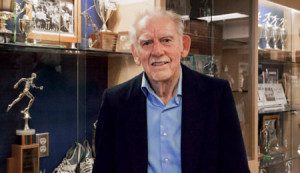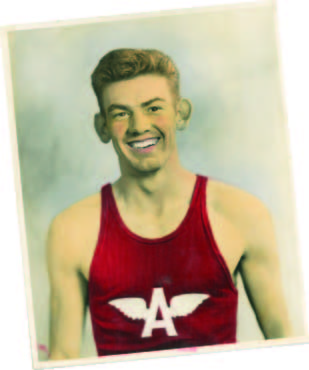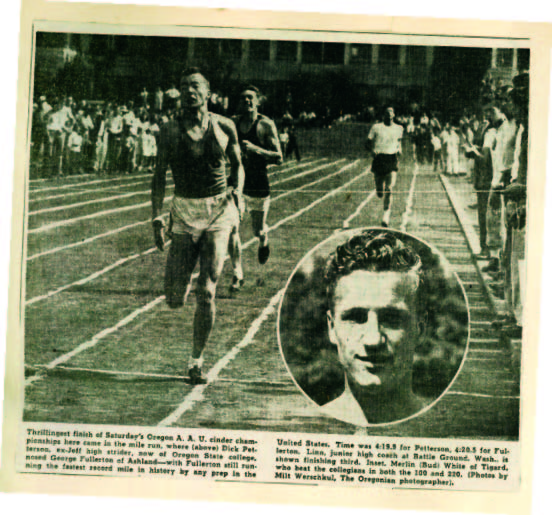Ahead by a mile
As a junior in high school, George Fullerton clocked a blistering 4:20.05, breaking the famed Louis Zamperini’s 1934 mile record. But it never made the record books.
On June 3, 1946, at a high school track in Portland, Ore., a gun fired and four crouched runners bolted forward. A modest crowd had gathered to watch the state’s fastest youth from the sidelines, their cheers rising as the runners’ heart rates increased after each corner. George Fullerton, who was 17 at the time, took the lead.
The Ashland High School teen’s feet—laced tightly into primitive racing shoes with spikes tacked to the bottoms, something he later described as leather shoes with nails through them—pounded the sandy track.
Unlike the other competitors, who paced themselves over the four laps it takes to run a mile, Fullerton gave it his all from the gun. He opened a huge lead in the first lap. He kept the lead into the second lap; his breathing staying calm and rhythmic.
“I didn’t have what you’d call leg speed, but I had stamina,” recalled Fullerton, who today is 86 years old.
On the third lap, Dick Petterson, a runner from Oregon State University, known then as Oregon State College, started to close the gap between Fullerton and himself.
In the final straightaway of the fourth lap, Petterson kicked hard and snapped the thin white yarn used as finishing tape, two strides ahead of Fullerton. Both men set personal records that day—but only Fullerton quietly made history.
Despite getting nipped at the line by a collegiate star, Fullerton, a high school junior, clocked a blistering 4:20.05.
It was the unofficial fastest mile ever run by a high school student. It was fast by any standards at the time, almost a decade before Roger Bannister became the first man to run a mile in under four minutes. However, it also stood among at least two other unofficial records, possibly making Fullerton’s time the third fastest mile recorded for a high school athlete.
Despite the undocumented records, Fullerton’s feat never earned the kind of accolades it would garner if something similar happened today.
Until recently, his mementos from the run were the red ribbon he earned from the race, newspaper clippings, an All-American High School Track Team accolade from Look magazine, a local parade and invitations to compete in other races.
The track meet had been organized by Oregon’s Amateur Athletic Union, which included college and high school runners. Official high school records don’t recognize races that include college athletes.
So Fullerton’s national achievement went largely unnoticed until one day in 2013 when his daughter, Candace Spiro, picked up a book at her local library near Seattle, Wash.
The record, broken
Laura Hillenbrand’s bestselling book, Unbroken, tells the story of track star and World War II hero Louis Zamperini. In 1934, Zamperini set a high school record by running the mile in 4:21.02. According to official records, that time stood until Bob Seaman ran the mile in 4:21 in 1953.
As a child, Spiro had learned about her father’s record-topping mile not from her father, but her mother. When she read about Zamperini’s record, she dug up a family scrapbook full of newspaper clippings. In another coincidence, that scrapbook happened to include a newspaper photo of Zamperini’s Los Angeles wedding. Next to it, on a yellowed piece of newsprint, Spiro confirmed her father’s time.
Fullerton (4:20.5) had shaved nearly a second off Zamperini’s record (4:21.02). If Fullerton’s time had been officially recognized as a new high school record, it would have stood until 1955, when Tom Skutka ran a mile in 4:19.05 in a New Jersey state meet.
Other young men had run faster than Fullerton and Zamperini, according to Jack Sheperd, who tracks high school records for the publication Track & Field News, confirmed in separate newspaper accounts. Chesley Unruh of El Monte, Calif., ran a 4:20.4 mile in 1925, and in 1943, Rudolph Simms, of Bronx, N.Y., ran a 4:18.2 mile. Like Fullerton’s, these times were clocked at events not sanctioned by the National High School Federation, and therefore they were not inked in official record books.
Today, Fullerton’s time has gained new recognition, sparked by national interest in the record he bested.
The movies
At a January screening in Clackamas, Ore., of the Angelina Jolie-directed film adaptation of Unbroken, Fullerton was introduced before the event as “the man who broke Zamperini’s record.”
It was a rare moment in the spotlight for a man who spent 20 years as the unheralded track and field and wrestling coach at Clark College, as well as a physical education instructor. Lately, Fullerton has been gaining recognition that some see as long overdue. The Unbroken connection has been covered in local newspapers. He was also tapped for the 2015 Clark College Athletics Hall of Fame.
Fullerton’s running career began almost by accident. Growing up, he and other children in his Ashland, Ore., neighborhood trekked miles to reach local fishing holes.
“I always got there first,” Fullerton said with a shrug. “They said, ‘Why don’t you run track?’”
During his sophomore year at Ashland High School, Fullerton joined the team. Not knowing how to race, he ran alongside the two other distance runners from his school. One day, during a time trial, the coach yelled for Fullerton to “take off” halfway through the run.
“That was it,” Fullerton said. He won handily, and went on to place second in the state championship that year.
Fullerton said he harbors no regret or resentment because his high school mile record didn’t go down in the history books.
Spiro said her father grew up during a time of war, when athletics were seen as more trivial than they are today. Sports were not sophisticated or ubiquitous, with children in almost every household dreaming of becoming a professional athlete.
Fullerton said he never thought to run on the cross-country team in the fall to better his track times in the spring, for example.
“Nobody ever said, ‘George, why don’t you run around the block a few times, it’ll make you faster,’” he said.
Nevertheless, he credited his steady improvement not to his track coach, but to a shop teacher who noticed his performance and began challenging him to run faster each week. The same teacher later convinced him to turn down a job offer at the local Harry & David plant, and accept one of the many college scholarships offered to him instead.
He passed along to his daughters the expectation that they would go to college. All four women attended Clark College—and then went on to four-year universities. His former wife, Lillian McDonough Fullerton, also graduated from Clark with a dental hygiene degree.
A listening coach
A foot injury ended Fullerton’s racing career as a freshman at Oregon State University, but he went on to earn a degree in human biology. He joined the Army and helped rebuild infrastructure in Germany following World War II. Then he returned home to teach physical education, eventually becoming the track and wrestling coach at Clark College.
“I decided, when I first started teaching, I’m going to listen to everybody,” he said.
One of Fullerton’s first runners at Clark was Mike Gaechter, a sprinter who also played football at Clark and went on to play for the Dallas Cowboys.
Fullerton said Gaechter showed him a technique that he called a hip roll. The trick is to rock the pelvis backward—as if pressing the lower spine against the back of a chair. This shift enables runners to lift their legs higher and lengthen their strides.
Fullerton, who worked at Clark from 1959 to 1989, coached all of his runners to run naturally around the short, curved parts of the track, and then roll their hips on the straightaway.
“I believe it was our secret weapon,” he said.
Fullerton got used to watching his runners pull away from the competition on the straight stretches of track. He led the team to three state championships.
Many of his students left Clark College to join the venerated track and field team at the University of Oregon, as well as other prestigious running programs.
“I would get average kids and make them a lot better because of what I learned from the other kids,” Fullerton said.
For recruiting purposes, he went to the Oregon and Washington high school championships every year. He noticed that a coach from Central Point, Ore., always seemed to have a javelin thrower in the state finals. One year, Fullerton approached him about his current entrant. The coach lamented a series of injuries and told Fullerton, “The kid I got now is my fourth-string javelin thrower.”
That student placed second in the state.
“I recruited him and had him teach me… from there on out, we had a javelin thrower every year,” Fullerton said.
Brian McNicholas was a middle distance runner at Clark College in 1969 before transferring to the University of Montana.
“I made the track team (at UM) as a walk-on because I’d been so well-coached at Clark College,” McNicholas said. Fullerton was the first person who taught him about nutrition.
“I remember him telling us to eat salad with nothing on it, just lettuce and tomatoes,” McNicholas said. “He said, ‘Eat a lot of rabbit food.’ I said, ‘What does that mean?’ And he said, ‘You ever seen a slow rabbit?’”
Fullerton expected his runners to train hard but he treated them with respect and dignity, McNicholas said. He encouraged his athletes and gave them confidence in themselves.
McNicholas said that as he prepared for a state championship, Fullerton assigned him an especially brutal workout. When he finished, Fullerton told him that the only other person he’d seen finish that workout as fast was Gaechter, who had gone on to play professional football.
“It probably wasn’t true, but it made me think, ‘Wow, I did that!’” McNicholas said.
Slower, but steady

George Fullerton, a record-breaking miler in high school, Clark track and wrestling coach and now a 2015 Athletics Hall of Famer.
Today, Fullerton is shorter than the 6-feet and one-half inches he once stood. He walks slowly, but still enjoys golf and fishing when he isn’t tending to his rental properties around Vancouver. Instead of running, he works up a sweat in the sauna several times a week.
Just as Fullerton’s high school performance has been dusted off and celebrated, so has his coaching career at Clark College. McNicholas nominated his former coach for the Clark College Athletics Hall of Fame and Fullerton was inducted
in February.
Fullerton is grateful that his talents landed him a college scholarship and a long, satisfying coaching career.
“It was fun,” he said. And record books or not, he added, “it was more fun winning than not winning.”
[hr]Lily Raff McCaulou is a journalist who lives in Portland, Ore. She is the author of Call of the Mild: Learning to Hunt My Own Dinner, which the San Francisco Chronicle named one of the best books of 2012. Her writing has appeared in The New York Times and The Atlantic.





